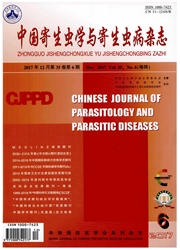

 中文摘要:
中文摘要:
目的 研究广东省南澳岛广州管圆线虫(Angiostronglus cantonensis)遗传多样性, 分析其与中国不同地区分离株间的系统发生关系。 方法 2015-2016年采用分层随机抽样法在南澳岛抽取3个行政村(宫前村、金山村和六都村), 选取55个采样点。用鼠笼捕鼠, 解剖鼠类收集广州管圆线虫成虫。现场采集福寿螺(Pomacea canaliculata)和玛瑙螺(Achatina fulica), 从螺类收集Ⅲ期幼虫, 实验室感染SD大鼠后收集成虫。提取成虫基因组DNA, PCR扩增核糖体DNA内转录间隔区2(internal transcribed spacer 2, ITS2)和线粒体DNA 细胞色素氧化酶Ⅰ亚基(cytochrome c oxidase subunit Ⅰ, COⅠ)并测序, 运用ClustalX1.83比对序列, DnaSP5.10分析其序列组成及遗传多样性。从GenBank上获取浙江温州(登录号HQ540551.1)、广东深圳(登录号HQ540546.1)、台湾花莲(登录号KF591125.1)等中国不同地区分离株的ITS2序列, 运用Mega6.06基于Kumara双参数模型计算遗传距离, 用邻接法(NJ)和最大简约法(MP)构建系统进化树, 分析各地区分离株的亲缘关系。 结果 从南澳岛共捕获鼠类110只, 广州管圆线虫感染阳性率为29.1%(32/110); 分别检测福寿螺和玛瑙螺1 190只和24只, 广州管圆线虫感染阳性率分别为6.1%(72/1 190)和83.3%(20/24)。PCR结果显示, 广州管圆线虫ITS2和COⅠ片段长度分别为693和1 174 bp, 位点变异率分别为4.7%和1.0%。南澳岛广州管圆线虫ITS2基因单倍型多样性指数为0.927, 核苷酸多样性指数为0.007, 平均核苷酸差异指数为4.549。COⅠ基因单倍型多样性指数为0.440, 核苷酸多样性指数为0.004, 平均核苷酸差异指数为3.743。基于ITS2的分析结果显示, 南澳岛与国内其他地区分离株遗传距离为0.181~0.775, NJ法MP法构建的系统进化树基本一致, 南澳岛大部分虫体序列与广东深圳、福建福清、云南普洱、广西南宁的分离株同属一大分支
 英文摘要:
英文摘要:
Objective To investigate the genetic diversity of Angiostrongylus cantonensis in Nan’ao Island of Guangdong Province, and analyze the phylogenetic relationship among A. cantonensis isolates in different regions of China. Methods Three villages (Gongqian Village, Jinshan Village and Liudu Village) were selected in Nan’ao Island using the stratified random sampling method during 2015-2016. Rodents were captured by the night feeding and trapping method and were dissected to collect adult worms. Pomacea canaliculata and Achatina fulica collected from fields were examined for the stage-Ⅲ larvae, which were then used to infect SD rats to collect adult worms. Genomic DNA was extracted from the adult worms, and PCR was performed to amplify internal transcribed spacer 2 (ITS2) and cytochrome c oxidase subunitⅠ (COⅠ). The PCR products were sequenced and aligned by Clustal X1.83. The genetic diversity was analyzed with DnaSP5.10. The ITS2 sequences of A. cantonensis from different areas in the country, such as Wenzhou in Zhejiang (Accession number HQ540551.1), Shenzhen in Guangdong (Accession number HQ540546.1), Hualian in the Region of Taiwan (Accession number KF591125.1), were obtained from GenBank or published reports. The genetic distances between these strains were determined with Mega6.06. The phylogenetic trees were constructed by the neighbor-joining (NJ) and maximum parsimony (MP) methods to analyze the phylogenetic relationship. Results A total of 110 rodents were captured and 32 were positive for A. cantonensis (29.1%). And 1 190 P. canaliculata and 24 A. fulica were examined, with a larva infection rate of 6.1% (72/1 190) and 83.3% (20/24), respectively. The amplification products of ITS2 and CO I of A. cantonensis had a length of 693 bp and 1 174 bp, with a site mutation rate of 4.7% and 1.0%, respectively. The haplotype diversity index, nucleotide diversity index, and the average nucleotide difference index were 0.927, 0.007 and 4.549 respectively in ITS2,
 同期刊论文项目
同期刊论文项目
 同项目期刊论文
同项目期刊论文
 期刊信息
期刊信息
